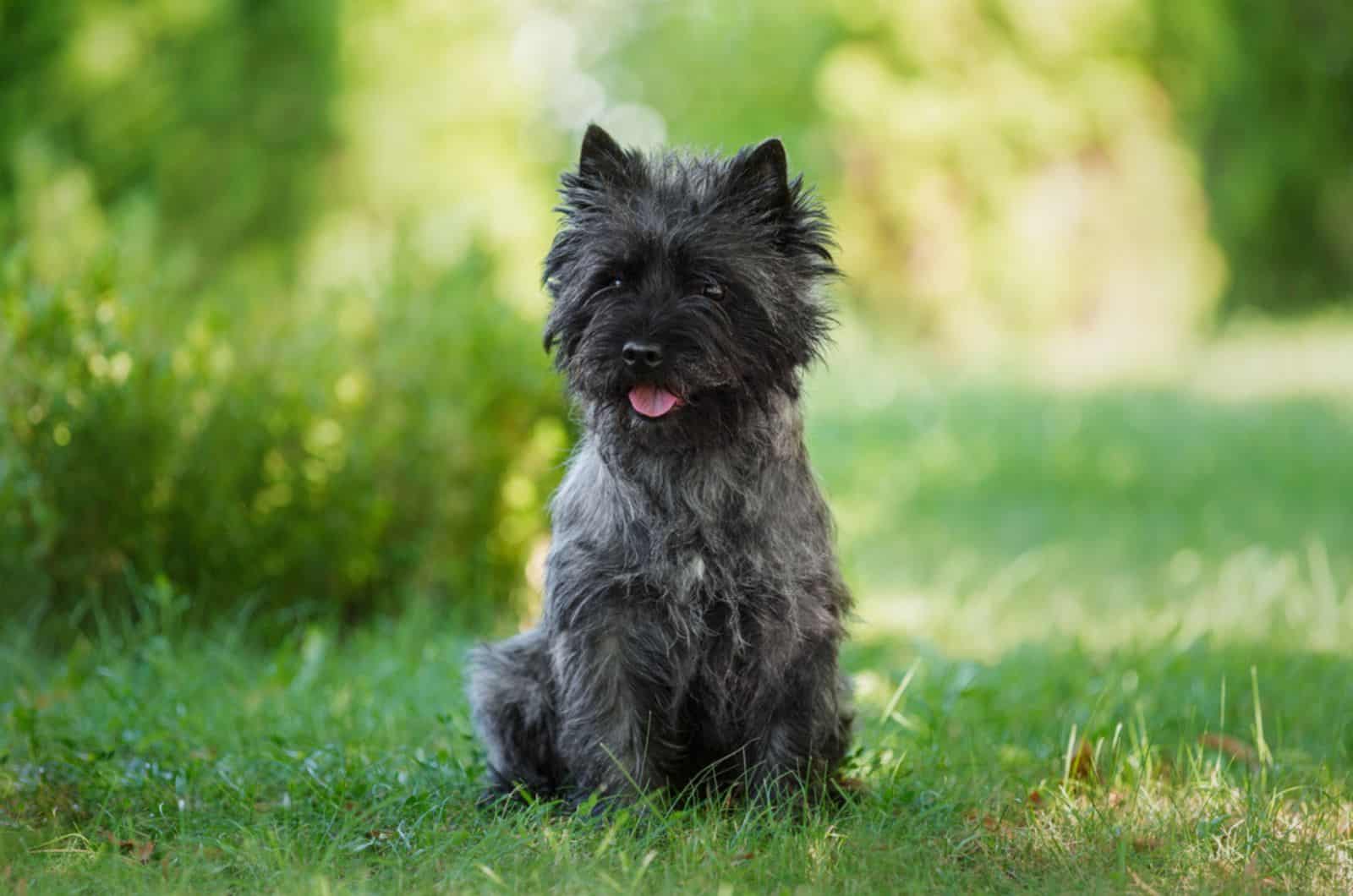It’s one of the smallest earth dogs and one of the most popular terriers because of the one and only ‘Toto’ from The Wizard of Oz.
They are shaggy-looking, small dogs that were initially bred to hunt small vermin, such as rats, but hunters would also use them for fox and badger hunting.
It is all because of their brave little heart and sturdy body. Yes, they do look small and fragile, but they are far from that! These dogs are solid-built and ready to do the work no matter the terrain.
But, how big do Cairn Terriers get? And, are there any big differences between a Cairn Terrier female and Cairn Terrier male?
Well, according to the American Kennel Club (AKC), when it comes to this small dog breed, there are slight, hardly-noticeable differences between males and females.
Some larger breeds have more noticeable size differences. For example, a Great Dane male can weigh 175 pounds, and a female can weigh 100 pounds. Or, the very popular Golden Retriever – the difference between a male and a female can be more than 20 pounds.
But, the adult weight of a Cairn Terrier is 14 to 16 pounds without any apparent size difference between a male and a female. Usually, a male is around 15 pounds, and a female is around 14 pounds.
They are also the same height — around 10 inches.
But, a Cairn Terrier puppy’s weight changes from month to month, and we are here to show you the Cairn Terrier growth chart and how this puppy develops from birth to adulthood.
Cairn Terrier Growth Chart
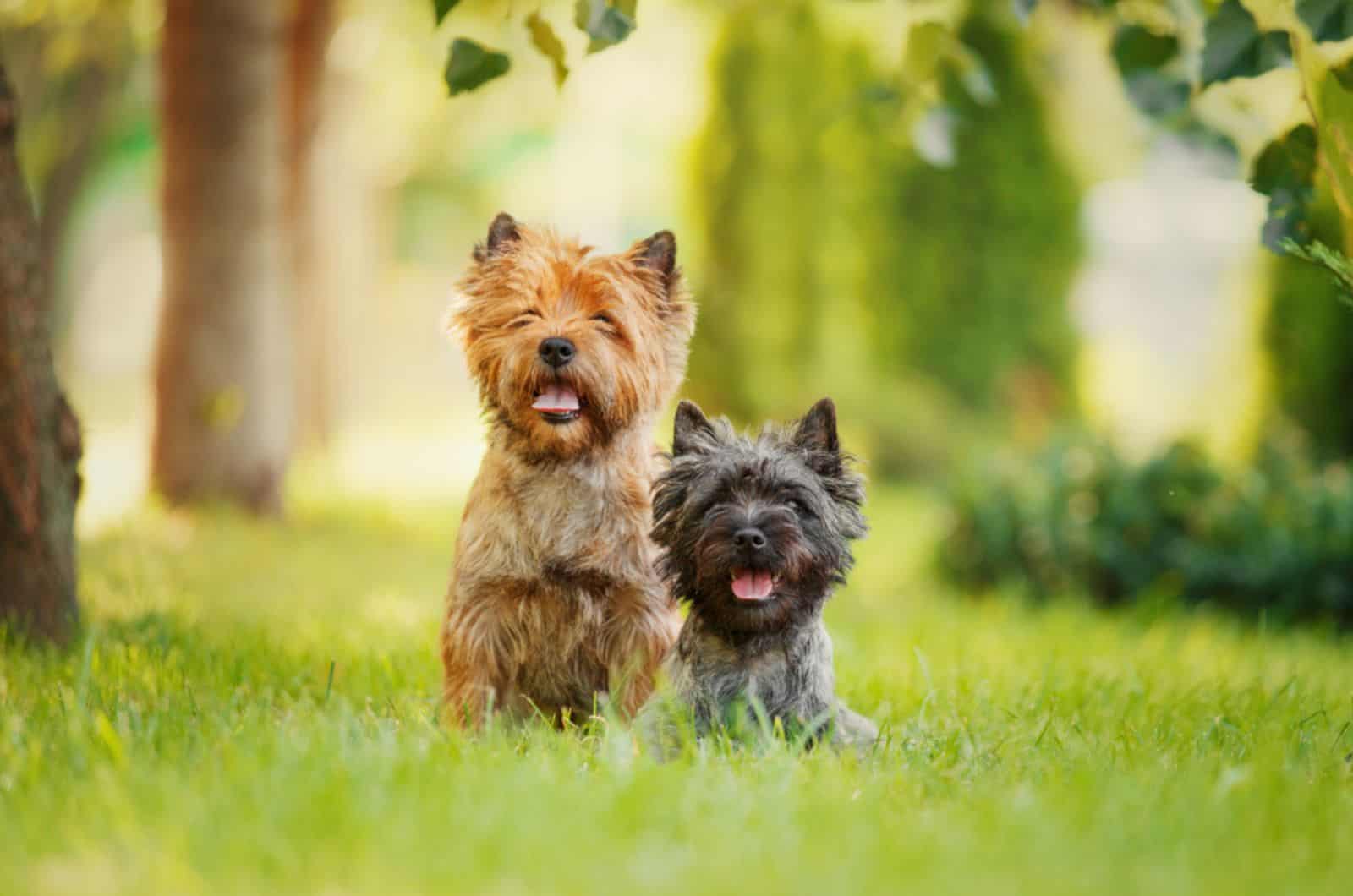
A growth chart can help us notice if something is not quite right with the development of a puppy. If the puppy is overweight or underweight, it can be a sign of an underlying issue. This issue can either be genetic or influenced by a disease or some other external factor.
That’s why by looking into the Cairn Terrier growth chart, we can notice the first signs of health issues in our pooches. A healthy weight is a sign that the puppy is developing properly, and that it has proper weight gain in coordination with muscle mass gain and skeletal growth.
A male Cairn Terrier is not a lot bigger than a female. You will see that they have approximately the same weight throughout different life stages.
We are going to focus on the weight chart, and mention the average full height of both males and females. We focus on the dog’s weight more because it fluctuates more than the height, and it can be influenced by various external and internal factors.
We’ll talk about the possible health issues that could influence and change the growth of a puppy, but for now, let’s take a look at the Cairn Terrier growth chart.
[table id=716 /]
* An adult Cairn Terrier is from 9 to 10 inches tall
Cairn Terrier Growth Through Different Life Stages
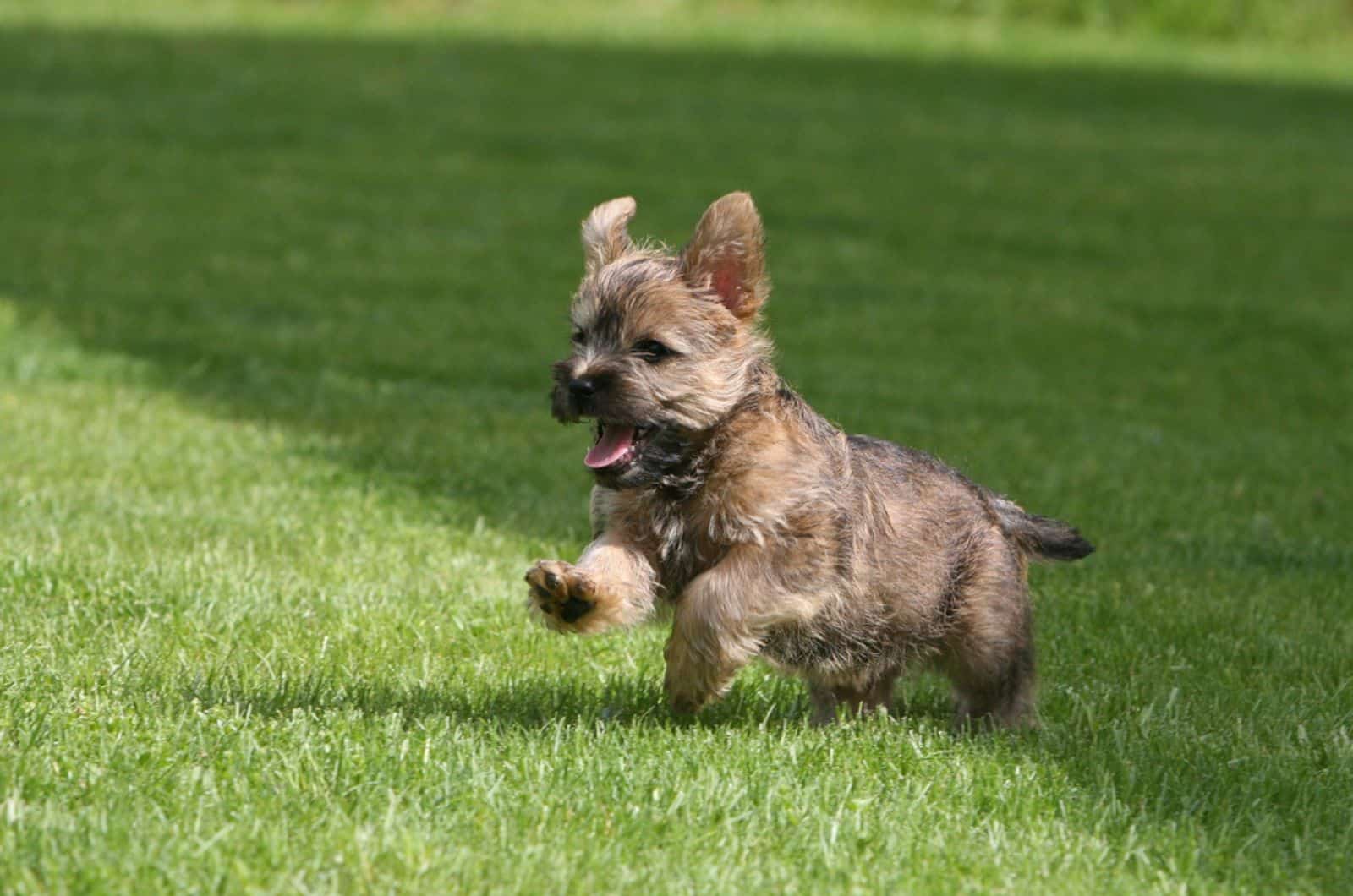
Just like any other mammal, puppies go through different developmental stages as well. They have one year to fully develop their size — in other words, gain average weight and height.
But, these Cairn Terrier growth chart numbers can vary. Some puppies will be smaller than average and others will be much bigger. This doesn’t have to mean that there is something wrong with your puppy.
There are many things that can change the puppy’s growth — from parasites to hereditary diseases and conditions. That’s why the weight is represented in pounds and kilograms, and it is not a precise number.
It is represented as an approximate weight that is most likely to be an average weight for a puppy depending on the puppy’s age. Once again, we are talking about healthy dogs, and we will mention influencing factors later.
Also, this is the growth chart of a purebred Cairn Terrier. If you think you might have a Cairn Terrier mix dog — you can check out this link to see what might be the size of your doggo: How to tell how big a mixed puppy will get?
From Birth to 3 Months
When puppies are born, their eyes are closed. They are not only blind, but deaf, too. This means that the only way they can find the warmth of their mom and the much-needed milk is through their sense of smell.
When Cairn Terrier puppies are born, they weigh less than one pound. They is a small dog breed, and their size is usually around 8 to 10 ounces at birth. We cannot tell the difference between a male and a female Cairn Terrier puppy according to their size when they are this small.
Sometimes, at birth, a female will weigh more than a male. This usually changes later as the puppies develop. However, it can stay the same — a female can either be bigger or the same size as a male.
What is important is that the puppies should double their size by the end of the first week of their life. This is the first checkpoint to see if the puppies are gaining weight properly.
First Days
Not only the first days, but the first hours are highly important in your dog’s future development. The first milk a female dog makes is called colostrum. It is incredibly rich in proteins and antibodies.
These antibodies need to get into the newborn puppies’ bloodstream and serve as the first and only line of defense against various bacteria and viruses. A puppy doesn’t have a developed immune system, and it cannot make antibodies on its own.
That’s why this first milk is so important for the future overall health of the dog. It’s the same with all mammals – not only dogs.
The only food they take is their mother’s milk, and it is all they need. You will see that the puppies will develop rapidly in the first few weeks, and their eyes will open, enabling them to start exploring their surroundings visually.
As the third month of age approaches, the puppies should weigh at least 4 pounds.
3 to 4 Months
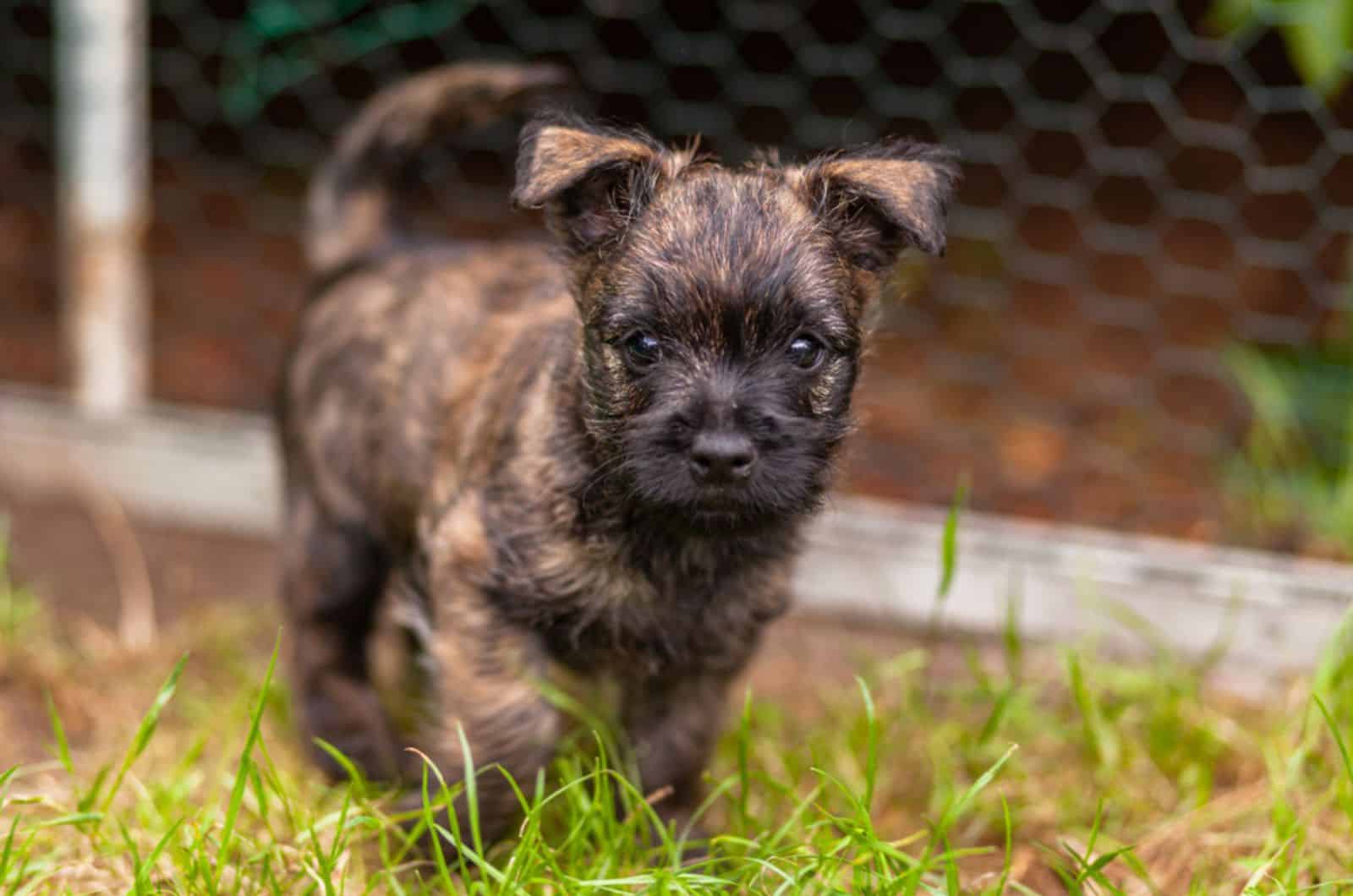
When the puppies reach three months of age, their weight should be from 4 to 5 pounds. This is an incredible period for the pups. They not only grow, but they learn so many things.
Because of this openness to learning and exploring, this is the perfect time to start the proper socialization of your puppies. Generally speaking, socialization is a process that starts from day one. But, the biggest effect can be achieved when the pups are from 3 to 6 months old.
Their doggy brain is making new neurons and synapses, soaking up knowledge with incredible speed. They learn new smells and sights, and they are at the best age to learn what is good and what is bad behavior.
This is the period when you should teach them how to behave towards other dogs and other pets — especially small pets! Cairn Terriers are true hunting dogs, and they have a high prey instinct. That’s why it is very important to teach them that small animals are not prey.
Because of their intellectual and social development, and because of the general development of their entire body — these puppies will need lots of puppy dog food (kibble) rich in proteins. Yes, that’s right — it’s time to give them solid food.
Weaning Process
This is a process in which a puppy transitions from a diet consisting entirely of its mother’s milk to solid dog food. It usually starts when the puppies reach their third week of life, but the real process begins at the beginning of the third month.
This is the perfect time to help our pups by starting to make them puppy mush. This is kibble soaked in either milk or warm water. This helps them learn that kibble is food, too, and at the same time, it enables them to actually eat the kibble without hurting their tiny erupting teeth.
According to the Cairn Terrier growth chart, the puppies grow bigger, and as they go through the weaning process, they should weigh from 5 to 5.5 pounds. The weaning process is a natural process that is followed by another natural process as well — teething.
Teething Process
This can be the most irritating process for both puppies and owners. Pups have two sets of teeth, just like humans — milky and adult teeth. The first set of teeth starts to grow and cause gum irritation, which can be quite painful sometimes.
This irritation can lead to puppies drooling excessively, whining while carrying toys, or they can start chewing everything! That can be quite a problem… so, what do you do?
Give your puppies chewing toys specially made for puppy teething problems. You can also give them a carrot or a treat bone to chew. You can also cool the chewing toys a bit. Colder temperatures can help with the irritation.
As for weight gain, the teething process can influence it. Some puppies might start eating less or completely refuse to eat. This is a passing problem, and it shouldn’t alarm you. But, if you think a puppy might have some health problems — take it to the vet.
5 to 6 Months
At the beginning of the fifth month, male and female Cairn Terrier puppies should weigh from 5.5 to 8 pounds. Males are usually slightly larger, but there are still no obvious differences.
The important thing is that the puppies are continuing to grow rapidly and adapt certain appropriate behavior in and outside the home. That means the process of socialization is still active, but they should have learned basic rules.
There is another important thing to consider when it comes to the Cairn Terrier. As they reach their sixth month of age, females can show signs that they are sexually mature and that they are in heat.
There are signs for a male dog as well, but if you don’t want a new litter of Cairn Terriers — pay attention to the females first. Females mature faster than males; hence, the urgency to pay attention to them first.
Small and medium-sized dogs usually mature sooner than large dog breeds. You can call your breeder and ask about your dog’s parents and see when they become sexually mature. But, of course, you can always consult your vet because each dog is unique.
7 to 8 Months
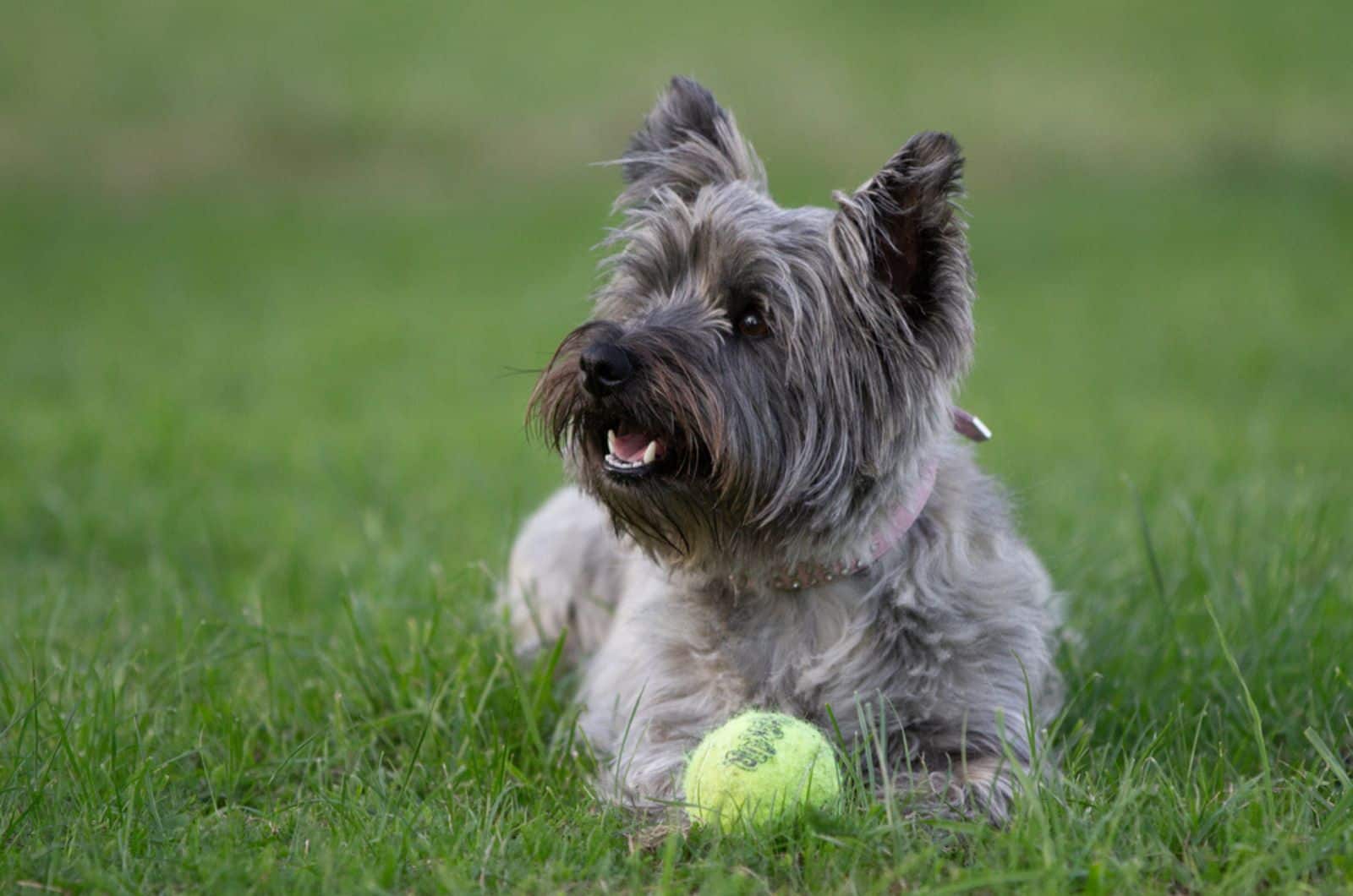
As the sixth month ends, according to the Cairn Terrier growth chart, puppies should weigh from 9.5 to 11 pounds.
They are true adolescent puppies now, with hormones raging in their bloodstream. Their socialization skills should be high enough to make them (and you) comfortable to go outside in any type of environment.
That means they should already be used to other dogs, pets, and strangers. They shouldn’t react scared, anxious, or aggressively towards any of them no matter if they are at the park or in their own yard.
The puppies are still growing, and they still need a lot of proteins to ensure their body has enough energy to support their growth. Remember that the Cairn Terrier is a very active and inquisitive little dog that loves to explore and sniff.
This is the time when you will certainly feel the strong will of a Cairn Terrier when it finds something that needs to be explored. So, a puppy fence is a must if you plan on leaving it outside in the yard.
But, don’t worry — puppies do get easier over time, and all those puppy blues you might have felt during the first couple of months will pass. And, don’t forget that there is nothing wrong with feeling overwhelmed from time to time.
This doesn’t mean you don’t care or love your pooches… it’s just a human reaction to a sudden change. And, a puppy is certainly a change, not to mention a couple of them.
9 to 10 Months
Nine-month-old Cairn Terrier puppies should weigh from 12 to 13 pounds. They still have a few pounds to gain until they reach adulthood.
They certainly look like adult dogs. Their coat is wiry and double-coated, which gives them a “shaggy” look. And, this type of coat means they don’t need a lot of grooming to keep it looking their best. An occasional bath and weekly grooming are enough.
When they turn ten months old, the puppies should weigh from 13 to 13.8 pounds. The puppies should receive two meals a day – one in the morning and the other one in the evening. This “puppy schedule” is supposed to be made when the puppies are starting their solid-food diet.
And, you should keep up with the schedule during their 9th and 10th month. You still don’t have to worry too much about obesity, especially if the puppies are eating two times a day, and have plenty of daily exercise.
However, if you don’t pay attention to their food intake and activity levels, you might have a dog with an obesity problem. An adequate dog’s diet and the proper amount of exercise every day are the keys to keeping your dog healthy and in good shape.
11 to 12 Months
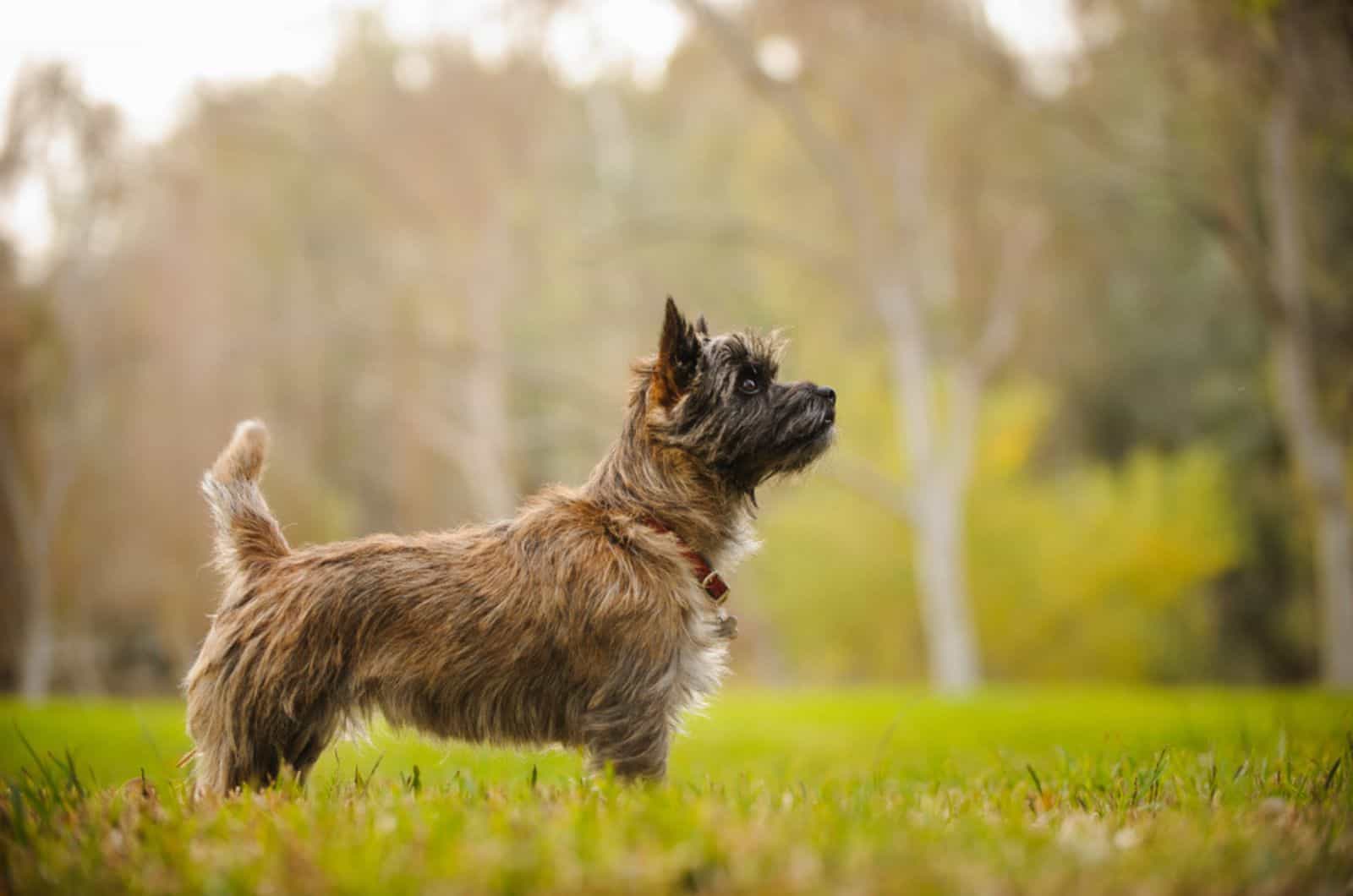
The puppies are entering their final puppy months. Soon, they will become adults, which means their growing phase will have ended. They can gain weight, but not height. This basically means that they can get overweight, but not taller.
When the puppies are 11 months old, their average weight should be from 13.8 to 14 pounds. And, finally… at the end of the 12th month, they should reach their adult size — weight from 14 to 16 pounds, and height around 10 inches tall.
The height is measured from the withers to the ground. The withers are the indentations between the shoulder blades. You should measure your dog from this point to the ground.
Even though your puppies look like adult dogs, they are technically still puppies, which means they still need high-quality puppy food. This food has a higher energy concentration, and it is usually made with highly digestible nutrients to help with energy intake.
Adult Years
When the dog reaches one year of age, it can be called an adult dog. Some large dog breeds need a few more months to fully grow and mature, but the Cairn Terrier is a small dog that stops its growth even before its first birthday.
Of course, there are differences between individual dogs, and some Cairn Terriers stop growing as soon as they are sexually mature. This is rare, but it can happen.
An adult Cairn Terrier dog should weigh from 14 to 16 pounds, and stand tall from 9 to 10 inches. Females are slightly smaller, so you can expect your female Cairn Terrier to be around 14 pounds, and 9 inches tall.
The important step is to switch from puppy food to adult dog food. You can either continue feeding them kibble or you can choose some other dog diet. The best decision is to consult your veterinarian. He or she can tell you which diet suits your dog the best.
It can be a raw diet, a boiled diet, or you can continue with dry food or canned food. The important thing is that the diet has all the necessary ingredients in order to maintain your dog’s health.
Senior Years
Senior dogs are more prone to obesity. This is the case with senior dogs because they don’t have the stamina and the desire to play and explore as when they were puppies or young-adult dogs.
This is a reality for Cairn Terrier dogs as well. Their average life expectancy is from 13 to 15 years. That means they can reach their senior years when they turn 10 or 13 — depending on the individual dog’s health and genes.
If you want to know whether your dog is overweight, underweight, or fits the appropriate average weight of a senior dog — you can use the Body Condition Score and see for yourself.
The score is presented in numbers, where the ideal score is 5. Everything under 5 is an underweight dog, and over five… an overweight dog.
What Can Influence The Cairn Terrier Growth Chart?
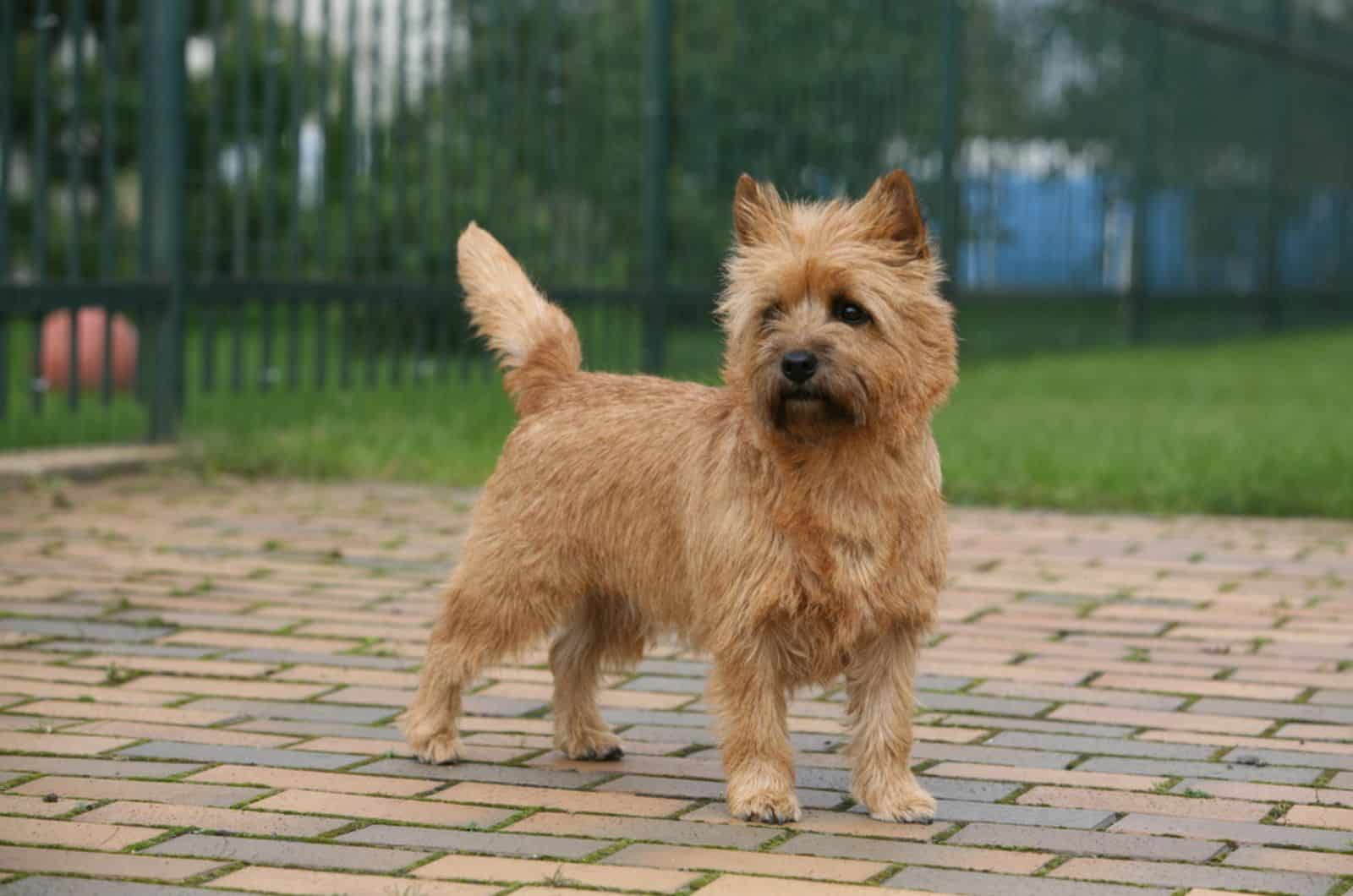
In the beginning, we mentioned that there are certain external and internal factors that can influence the Cairn Terrier growth chart.
These factors can influence the puppy’s growth during all stages of its development. Some of them are treatable and easy to take care of, but some are impossible to treat. Generally speaking, most internal factors that influence the growth of a puppy are hereditary diseases and conditions.
Some of the most common external factors are parasites, bacterial and viral diseases, and infections, as well as the dogs’ diet and food intake.
Parasites
Cairn Terrier puppies can be infected by roundworms and hookworms — the most common external factors. These parasites latch onto the inner wall of the small intestine and eat the food that the puppy ingests.
This means that the dog has an appetite and eats a lot, but still loses weight. Puppies infected with worms either have a typical potted belly or a large, bloated-looking belly. The good thing is that both roundworms and hookworms are easily treatable.
There is a spot-on and oral medication that can be given to puppies to clear them from these parasites. The process is called deworming, and it should be repeated every few months. It is something that every responsible dog owner does to all of their dogs regularly.
Signs That A Puppy Has Parasites
Besides a bloated belly, there are other signs that can tell us that a puppy has hookworm or roundworm infestation:
- A pot belly (bloated-looking)
- A thin coat
- Losing weight
- Staying underweight despite the food intake
As soon as the puppy is cleared of these parasites, it goes back to normal — gaining weight, and having healthy-looking fur and a normal belly size.
Genetics
The most important factors that determine the size of a dog are genes. They play a vital role, and can influence the size of a puppy both in-utero and after birth. Hereditary or genetic diseases are common, and they have to be considered.
If you want to get a Cairn Terrier puppy, you should always buy the puppy from a responsible breeder who can show you the health clearance of the puppy’s dog parents. This means they have a DNA test done to prove their breeding dogs don’t have hereditary diseases.
One of the diseases that can be hereditary is hypothyroidism. This health condition is responsible for increased weight gain in dogs. You can always ask for health-clearance proof from a breeder in order to make sure they are clear of this condition that can cause other problems, too.
Neutering/Spaying
When it comes to neutering or spaying, there is a debate about whether it can influence weight or not. One thing is certain – dogs without sex hormones won’t have the need to roam and avoid food because “they have somewhere to be”.
Luckily, neutering (removing the testicles) or spaying (removing ovaries and uterus) do not influence the health and growth of a Cairn Terrier that much. This is because this is a small dog, and they become sexually mature around the sixth month.
This means the Cairn Terrier dog has already stopped bone and joint development, and there won’t be big differences after spaying/neutering.
However, if you want to be sure, and you can wait, you can consult the vet and wait until the dog is fully grown — one year old.
This doesn’t mean there are no changes at all. You can see there are changes in behavior in female dogs and in male dogs after the procedure has been done.
Diet
However, these changes won’t drastically influence their weight. What will influence their weight is food and diet. You have to continue giving your dog high-quality food. This means that the food is rich in proteins, vitamins, and minerals, and low in carbohydrates.
Take time and look at the label on the dog’s food you buy. See the percentage of proteins and carbohydrates. There are a lot of fillers in canned dog food, which usually have no nutritive value.
Look for those brands and types of dog food that have a high protein percentage. You can also take the shortcut and ask your vet. They can recommend the best dog food for your dog.
High-quality food won’t just make an impact on your dog’s weight, but also on its overall health and lifespan.
The Conclusion
The Cairn Terrier growth chart is a great “tool” to help you keep an eye on your dog’s development. You can easily check the chart and see if your puppy is growing properly. Of course, every dog is unique.
This means that you don’t have to worry if your dog’s weight is not within those numbers. They might be smaller or bigger than the average. If they are looking and acting healthy, then there is nothing to worry about.
You can always take your dog to the vet for a checkup. The vet can examine your dog, and even do some blood tests to make sure everything is alright. But, in most cases, blood tests are not required.
To sum it up… the Cairn Terrier is a small dog that goes through rapid growth until it reaches one year of age, when it is fully grown. When the dog is one year old, it should weigh from 14 to 16 pounds (7.5 to 9 kilograms), and it should be from 9 to 10 inches tall (23 to 25 centimeters).
In essence, the important thing is that your doggo is healthy and happy. To make sure it stays that way, take it for regular vet checks and vaccinations, feed it high-quality dog food, make sure it has lots of exercise, and give it regular anti-parasitic medication (for external and internal parasites).
And, of course — give it lots of love and cuddles!
